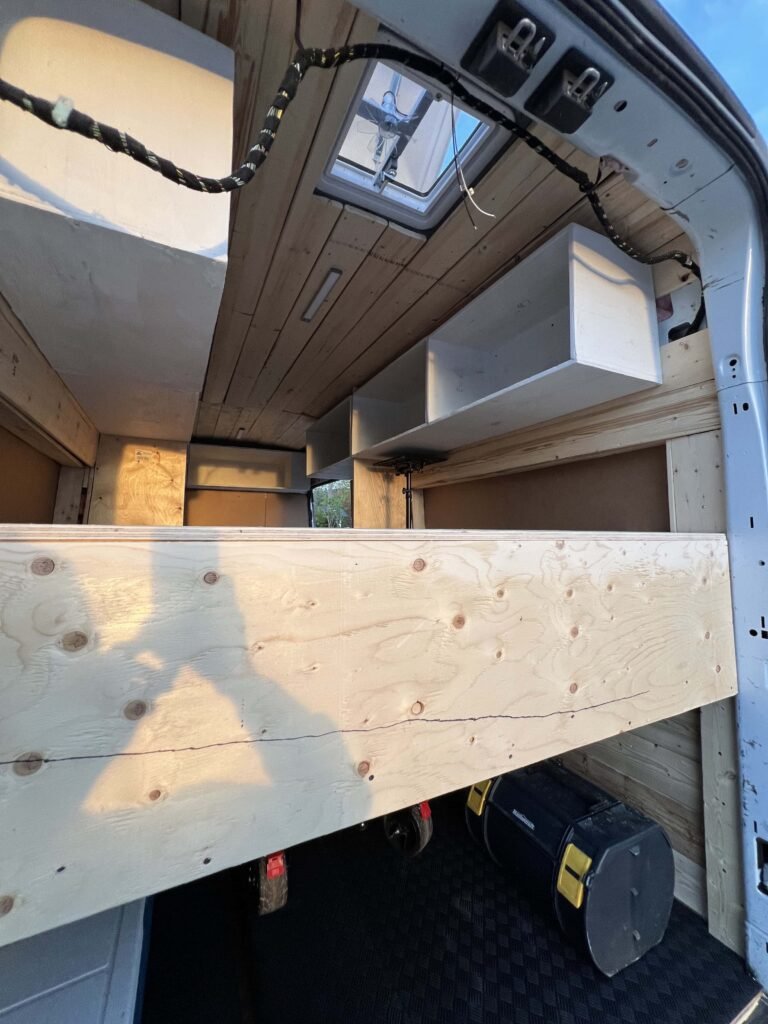Imagine waking up to crisp mountain air on a summer adventure, only to be greeted by a stifling sweatbox inside your van. Or picture yourself shivering through a winter night, bundled beneath layers but still feeling the cold seep in. These scenarios can quickly turn your dream van life into a discomforting reality.
The good news is, achieving year-round comfort in your van is entirely possible! This comprehensive guide will equip you with everything you need to create a cool and refreshing haven in the summer and a warm, cozy retreat in the winter. We’ll delve into various cooling, heating, and ventilation solutions, catering to DIY enthusiasts and those seeking professional installation options.
Doing van life anywhere but in the southern hemisphere? You’ll need climate control that can take you across all 4 seasons. That’s why we’re going to show you how to install a heating, cooling and ventilation system. The best type of heater is a Chinese diesel heater (not propane) because it provides dry heat, takes up very little power and is relatively inexpensive to heat (approx. 1-2 gallons of diesel per night). For cooling, there are some pretty costly options on the market targeted primarily at RV owners, but you can opt for a relatively inexpensive ductless rooftop mechanical AC. Lastly, ventilation simply requires a roof vent of which there are many options. I’d pick one with a fan that doesn’t cost too much. BUT, ceiling it right will prevents any major leaks during heavy rain!
The different types of heaters for vans
Keeping your van toasty during chilly nights is crucial for a comfortable van life experience. But not all van heaters are created equal. Let’s explore the most common types of van heaters, their advantages and disadvantages, to help you choose the perfect solution for your needs:
1. Diesel Heaters:
- Pros:
- Highly Efficient: Diesel heaters boast superior fuel efficiency, burning diesel fuel directly from your van’s tank or a separate auxiliary tank. This translates to longer heating times on less fuel, perfect for extended off-grid adventures.
- Powerful Heating: Diesel heaters pack a punch, capable of warming even large vans quickly and effectively. They’re ideal for those venturing into frigid climates.
- Quiet Operation: Modern diesel heaters operate with minimal noise, ensuring a peaceful night’s sleep even while heating.
- Cons:
- Installation Complexity: Installing a diesel heater often requires professional assistance due to the need for proper ventilation and fuel line connections.
- Higher Initial Cost: Diesel heaters typically have a higher upfront cost compared to other options.
- Maintenance Requirements: Regular maintenance is crucial for optimal performance and safety.
2. Propane Heaters:
- Pros:
- Relatively Easy Installation: Propane heaters can often be DIY-installed, making them a good option for the handy vanlifer.
- Readily Available Fuel: Propane is a widely available fuel source, easily refillable at gas stations or camping stores.
- Multiple Options: Propane heaters come in various sizes and configurations, allowing you to choose the best fit for your van’s size and heating needs.
- Cons:
- Fuel Consumption: Propane heaters tend to be less fuel-efficient compared to diesel options, requiring more frequent refilling.
- Moisture Production: Propane combustion generates moisture, making proper ventilation essential to prevent condensation buildup inside your van.
- Safety Concerns: As with any propane appliance, proper safety precautions and carbon monoxide detector use are vital.
3. Electric Heaters:
- Pros:
- Clean and Silent Operation: Electric heaters are environmentally friendly and operate quietly, ideal for those seeking a noise-free heating solution.
- Easy Installation: Electric heaters are often the simplest to install, requiring connection to your van’s electrical system.
- Cons:
- Power Consumption: Electric heaters can drain your van’s battery quickly, especially in colder climates. They’re best suited for mild weather conditions or as a supplementary heating source.
- Limited Availability of Shore Power: Finding reliable shore power hookups can be challenging, especially when boondocking.
While diesel heaters reign supreme in terms of efficiency and power, the best choice for your van ultimately depends on your budget, technical skills, and travel style. Weigh the pros and cons of each option to find the perfect solution for conquering the chill and creating a cozy haven on wheels!
Installing a Chinese diesel heater in your van
Let’s face it, when it comes to van life, battling the cold shouldn’t be a battle of complex installations. That’s where all-in-one diesel heaters shine. These compact units integrate the heater, fuel pump, and control panel into a single, user-friendly package. Here’s why an all-in-one diesel heater might be the perfect solution for keeping your van toasty:
- Simplified Installation: Forget the hassle of mounting a separate pump and connecting it to your van’s fuel tank. All-in-one heaters have a built-in pump that draws fuel directly from a small auxiliary tank you install inside the van. This translates to a cleaner, less time-consuming installation process, perfect for DIY enthusiasts.
- Space Saving Design: All-in-one units are remarkably compact, freeing up valuable storage space in your van. Their integrated design eliminates the need for bulky pumps and extra hoses.
Now, before diving into the installation process, safety is paramount. Here are some crucial considerations:
- Location, Location, Location: Choosing the right spot for your heater is essential. Ensure it’s positioned away from flammable materials and has adequate clearance for proper airflow. Avoid placing it directly on the floor; instead, elevate it using fire-resistant materials like 2x4s to create a safe air gap underneath.
- Penetrating Prowess: Drilling the exhaust and intake holes requires meticulous planning. Double-check measurements to avoid hitting any electrical wires or plumbing. Remember, high-temperature sealant is your best friend here. It creates a secure barrier around the exhaust hole, preventing fire hazards and pesky carbon monoxide leaks.
Safety First, Comfort Follows:
Equipping your van with a fire detector and a carbon monoxide detector is non-negotiable. These life-saving devices provide an extra layer of peace of mind while enjoying the warmth of your diesel heater.pen_spark
The different types of ACs for vans
Beating the heat on the road is crucial for a comfortable van life experience. But when it comes to van air conditioning (AC), a one-size-fits-all approach doesn’t exist. Let’s explore the two main types of van AC units and their unique characteristics:
1. Ductless Mini-Splits:
- Cool Concept: Ductless mini-splits are comprised of two main components: an outdoor condenser unit mounted on your van’s roof and an indoor evaporator unit installed within the living area. These units function similarly to home air conditioners, providing efficient cooling without bulky ductwork.
- Pros:
- Targeted Cooling: Ductless mini-splits allow for precise temperature control in specific areas of your van, maximizing efficiency.
- Easy Installation: Compared to traditional AC units, ductless mini-splits require minimal installation modifications, making them a good option for DIY enthusiasts.
- Space Saving: The lack of ductwork frees up valuable interior space in your van.
- Cons:
- Multiple Units for Larger Vans: For larger vans, you might need multiple mini-splits for effective cooling throughout the living space.
2. Roof-Mounted AC Units:
- Traditional Powerhouse: Roof-mounted AC units are the classic choice for van air conditioning. They consist of a single unit mounted on the roof, housing both the condenser and evaporator coils. Cool air is then distributed throughout the van via a network of ducts.
- Pros:
- Cost-Effective (Generally): While the upfront cost can vary depending on the model, roof-mounted AC units are generally more affordable than ductless mini-splits.
- Powerful Cooling: These units can effectively cool down even larger vans, making them ideal for hot climates.
- Cons:
- Installation Complexity: Installing a roof-mounted AC unit typically requires professional assistance due to the need for roof modification and ductwork installation.
- Space Consumption: The roof unit and ductwork can take up valuable headroom inside your van.
- Uneven Cooling: Depending on the duct layout, achieving consistent cooling throughout the van might be challenging.
Choosing the right AC unit for your van depends on several factors, including:
- The size of your van: Larger vans might benefit more from the powerful cooling of roof-mounted units, while smaller vans might find ductless mini-splits more efficient.
- Your budget: Ductless mini-splits, while generally less expensive upfront, can have additional costs depending on the number of units needed for your van size.
- Your DIY skills: If you’re comfortable with some technical work, ductless mini-splits might be a good candidate for self-installation. For roof-mounted units, professional assistance is typically recommended.
- Your desired cooling experience: Ductless mini-splits offer precise temperature control, while roof-mounted units prioritize overall cooling power.
Installing a ductless AC ceiling unit in your van
Ductless mini-splits offer a sleek and efficient cooling solution for your van. This section will guide you through the installation process of a ceiling cassette unit, a popular choice for its even air distribution and aesthetics. Remember, for safety reasons, consulting a qualified technician is highly recommended, especially for tasks involving electrical work and refrigerant lines. That being said, here’s a general overview of the steps involved:
Tools and Materials:
- Drill with various drill bits (metal, wood)
- Hole saw (size matching the unit’s refrigerant line and condensate drain)
- Level
- Screwdrivers (Phillips and flathead)
- Wire cutters/strippers
- Sealant
- Caulking gun
- Condensate pump (if needed, depending on your drainage plan)
- Electrical tape
- Safety glasses and gloves
- Your ductless mini-split AC unit (indoor cassette unit, outdoor condenser unit, connecting lines, and accessories)
The Installation Process:
- Choosing the Location: Select a central location on your van’s ceiling, ensuring proper airflow and avoiding obstacles. Use a level to ensure the unit will be perfectly horizontal.
- Drilling the Holes: Mark the drill spots for the refrigerant line set, condensate drain line, and electrical cables (refer to your unit’s manual for specific measurements). Carefully drill the holes through the ceiling, roof, and exterior wall using the appropriate drill bits and hole saw.
- Routing the Lines: Feed the refrigerant lines, condensate drain line, and electrical cables through the drilled holes, ensuring they don’t kink or twist.
- Installing the Indoor Cassette Unit: Following the manufacturer’s instructions, mount the indoor cassette unit flush against the ceiling, making secure electrical connections and securing the refrigerant and condensate drain lines.
- Installing the Outdoor Condenser Unit: Mount the outdoor condenser unit on a sturdy bracket on your van’s roof, ensuring proper ventilation and following manufacturer guidelines for clearance from walls and the roof. Securely connect the refrigerant lines and electrical cables following the provided instructions.
- Drainage Considerations: Depending on your van’s layout, gravity might not be sufficient to drain the condensate. If needed, install a condensate pump according to the manufacturer’s instructions to ensure proper condensate drainage.
- Sealing and Finishing Touches: Seal all gaps around the drilled holes on the ceiling, roof, and exterior wall using appropriate sealant to prevent leaks and improve insulation. Caulk any remaining gaps for a clean finish.
- Electrical Connection: Connect the electrical wiring to your van’s electrical system following the unit’s manual and local electrical safety codes. It’s crucial to consult a qualified electrician for this step.
- Vacuuming and Leak Testing: Once everything is connected, evacuate the air from the refrigerant lines using a vacuum pump (refer to the unit’s manual). Perform a leak test to ensure the system is sealed before adding refrigerant.
- Final Touches: Top up the refrigerant according to the manufacturer’s specifications and test the operation of your new AC unit!
Remember, this is a general guideline, and the specific steps may vary depending on your chosen ductless mini-split model. Always refer to the manufacturer’s installation manual for detailed instructions and safety precautions.
Installing a ceiling vent in your van
A roof vent plays a crucial role in maintaining good air circulation and preventing moisture build-up in your van. Here’s a breakdown of the steps involved in installing a roof vent:
Tools and Materials:
- Jigsaw or reciprocating saw
- Drill with various drill bits (metal and wood)
- Screwdriver (Phillips head)
- Rivet gun (optional, for some vent models)
- Sealant (butyl tape or sealant recommended for RV applications)
- Caulk
- Tape (painter’s tape for marking)
- Safety glasses and gloves
- Power source (optional, if using a power drill)
- Your chosen roof vent (including installation hardware and any specific instructions)
Choosing the Location:
- Strategic Placement: For optimal ventilation, aim to position the vent towards the back third of your van roof, allowing for airflow throughout the living space. Avoid placing it directly over electrical components or furniture.
- Mind the Clearance: Ensure there’s enough clearance between the vent and any roof racks or other accessories.
Making the Cut:
- Mark Your Spot: Carefully measure and mark the exact location for the vent opening on your van’s roof using painter’s tape. Double-check your measurements before proceeding.
- Cutting Time: Using your jigsaw or reciprocating saw (whichever is more comfortable for you), carefully cut out the roof opening according to the markings. Be mindful of maintaining a clean and straight cut.
Preparing the Opening:
- Deburring: Once the hole is cut, use a file or sandpaper to smooth out any rough edges on the metal roof to prevent cuts during installation.
- Prepping the Base: (Note: This step might vary depending on your vent model) If your vent uses a flange that sits underneath the roof for additional support, you might need to drill pilot holes for screws or rivets to secure the flange before placing the vent unit on top.
Installing the Vent:
- Seal it Up: Apply a generous bead of sealant (butyl tape or RV sealant is recommended) around the underside of the vent flange to create a watertight seal.
- Securing the Vent: Carefully position the vent unit on the roof, aligning it with the cutout hole. Using the provided hardware (screws or rivets), securely fasten the vent to the roof, ensuring a tight and leak-proof fit.
- Sealing the Exterior: Once the vent is secured, apply a bead of caulk around the exterior perimeter of the vent where it meets the roof to create a finished look and additional protection against leaks.
Optional: Power Source for Fans:
If your vent incorporates a fan, you might need to run electrical wiring from the vent to a power source inside your van. This step typically involves drilling additional holes for running the wires and installing appropriate connectors. Consult a qualified electrician for this task to ensure proper electrical safety.
Congratulations! You’ve successfully installed a roof vent on your van. Remember, this is a general guide, and specific steps might vary depending on your chosen roof vent model. Always refer to the manufacturer’s instructions for detailed installation procedures and safety precautions.

Summary
Congratulations! You’ve explored the exciting world of van climate control. From efficient diesel heaters to strategically placed roof vents, you now possess the knowledge to create a comfortable haven on wheels, ready to conquer any season.
Remember, for a seamless van life experience, a well-functioning electrical and plumbing system is crucial. In last week’s post (Week 10: Electrical and Plumbing), we delved into the essentials of wiring your van and installing plumbing components. Don’t miss out on this valuable information to ensure your van is equipped for all your off-grid adventures!
Feeling empowered to tackle your van’s climate control system yourself? Remember, safety is paramount. Refer to the manufacturer’s instructions for each component, and don’t hesitate to consult with qualified professionals when needed.
The journey to your dream van continues! Ready to dive deeper into the world of van life? Join our thriving DIY Camper Build community for inspiration, support, and expert advice as you bring your van life vision to life. Share your questions, challenges, and successes with fellow vanlifers, and learn from their experiences. See you there!





